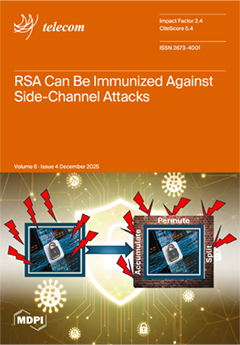The global shift to digital terrestrial television broadcasting (DTTB) from the conventional analogue has significantly transformed television culture, necessitating comprehensive technical and infrastructural evaluations. This study addresses the limitations of existing path-loss models for accurately predicting path loss in digital terrestrial television broadcasting
[...] Read more.
The global shift to digital terrestrial television broadcasting (DTTB) from the conventional analogue has significantly transformed television culture, necessitating comprehensive technical and infrastructural evaluations. This study addresses the limitations of existing path-loss models for accurately predicting path loss in digital terrestrial television broadcasting in the UHF bands, motivated by the need for reliable, location-specific models that account for seasonal, meteorological, and topographical variations in Abeokuta, Nigeria. The study focuses on path-loss prediction in the UHF band using Ogun State Television (OGTV), Abeokuta, Nigeria, as the transmission source. Eight receiving sites, spaced 2 kilometers apart, were selected along a 16.7 km transmission contour. Daily measurements of received signal strength (RSS) and weather conditions were collected over one year. Seasonal path-loss models
for the wet season and
. For the dry season, models were developed using multiple regression analysis and further optimized using least squares (LS) and gradient descent (GD) techniques, resulting in six refined models:
,
,
,
,
, and
. Model performance was evaluated using Mean Absolute Error, Root Mean Square Error, Coefficient of Correlation, and Coefficient of Multiple Determination. Results indicate that the Okumura model provided the closest approximation to measured RSS for all the receiving sites, while the Hata and COST-231 models were unsuitable. Among the developed models,
(
,
,
,
,
) and
(
,
,
,
,
) were found to be the most suitable models for the wet and dry seasons, respectively. The major influence of location-based elevation and meteorological data on path-loss prediction over digital terrestrial television broadcasting communication lines in Ultra-High-Frequency bands was evident.
Full article





